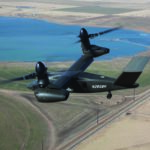
Space Adviser. Deputy Defense Secretary Pat Shanahan will take over the duties of the principal defense space adviser on an “interim” basis, he wrote in a Jan. 17 memo to other defense officials. The move comes in response to the fiscal year 2018 defense authorization act, which calls for taking that job away from the Air Force secretary and assigning it to someone else as part of a space management overhaul.
Space Vice Commander. The Air Force has told the four congressional defense panels that it plans to appoint a three-star general to serve as vice commander of Air Force Space Command and be located in the National Capital Region, a service spokesman says. The new official will help the command’s commander in his new role as the sole authority for organizing, training and equipping all Air Force space forces. The commander received that responsibility under the recently enacted fiscal year 2018 defense authorization act.
Shutdown Meeting. President Donald Trump met with Secretary of Defense James Mattis, Deputy Secretary of Defense Patrick Shanahan, and the Joint Chiefs Staff to discuss Department of Defense preparedness in case a potential government shutdown occurs. The president expressed his continued commitment to supporting our warfighters with increased and predictable funding to achieve peace through strength, according to a statement from the White House. The president urges Congress to pass a defense budget that enables the rebuilding of the U.S. Armed Forces by restoring readiness, growing the size of our force, and modernizing our capabilities. Trump also emphasizes the role of the Congress in the potential shutdown and the need for Members of Congress to move quickly to approve a budget so the nation remains fully protected.
SBIRS Launch. The Air Force’s fourth Space Based Infrared System (SBIRS) geosynchronous Earth orbit (GEO Flight-4) missile-warning satellite was supposed to lift off Jan. 18 on a United Launch Alliance (ULA) Atlas 5 rocket from Cape Canaveral Air Force Station in Florida. But the launch was scrubbed “due to a ground issue associated with the booster liquid oxygen system,” ULA says. The launch is now planned for Jan. 19 at 7:48 p.m. Eastern time.
NASA Nominee. The Senate Commerce, Science and Transportation voted along party lines Jan. 18 to approve the nomination of Rep. Jim Bridenstine (R-Okla.) to be NASA administrator. The nomination received a similar vote in November but was returned to the White House after failing to receive Senate confirmation by year’s end. Opponents say a politician should not run what has traditionally been a nonpartisan agency.
Romanian Vehicles. General Dynamics European Land Systems signed a contract to deliver up to 227 PIRANHA 5 wheeled armored vehicles in six different configurations to the Romanian Armed Forces. The contract has a total value exceeding $1 billion. It is part of the Romanian army’s plan to modernize its legacy wheeled armored vehicle fleet. The vehicles will be produced in Romania under a strategic cooperation and transfer of technology project between GD European Land Systems – Mowag and the Romanian company Uzina Mecanică București. Romania’s armed forces have fielded variants of PIRANHA vehicles since 2006. They are deployed in various missions in-country and abroad, demonstrating its reliability and performance. “The Romanian Army is one of the most important PIRANHA users in Europe. We are very honored by this contract award as it reflects the high confidence and satisfaction the Romanian Army has in our vehicles,” says Oliver Dürr, vice president for wheeled vehicles and managing director of General Dynamics European Land Systems – Mowag.
Army Network. The Army’s Transportable Tactical Command Communications, T2C2, is granted approval to proceed to full rate production (FRP). The FRP decision enables the program office to procure and field the expeditionary inflatable satellite system to Army units. “T2C2 provides commanders and soldiers with the communications agility and operational flexibility they need to help them retain overmatch against very capable adversaries,” says Lt. Col. Jenny Stacy, product manager for satellite communications and tactical network project manager. T2C2 provides a significant improvement in transportability, bandwidth, and set up speed over compared to current capabilities. Because the T2C2 solution is inflatable, it can provide a larger dish size, with increased capability and bandwidth efficiency, in a smaller transport package. Both the air-droppable T2C2 Lite 1.2 meter satellite terminal and Heavy 2.4 meter satellite terminal provide high-bandwidth network communications and mission command for initial entry and forward operations. Once on the ground and an airfield is seized, Soldiers can rapidly set up their T2C2 inflatable satellite terminal, enabling continuity of mission command during the initial phases of operation. Later in the mission, when follow-on forces fly in larger network assets, commanders can extend the battle space using T2C2 to support company-size forward operating bases and special team-size elements that need an easily transportable network capability.
Border Patrol sUAS Interest. Customs and Border Protection has issued a Request for Information to identify “proven … fully developed … open architecture systems” that can meet the Border Patrol’s requirements for small unmanned aircraft systems (sUAS). The Border Patrol is interested in the sUAS to improve its situational awareness and provide reconnaissance, surveillance and target acquisition capabilities along the southern and northern borders. The solution must be transportable on a 4 x 4 vehicle over rugged terrain, operate day and night, and require little maintenance. The Coast Guard is in the process of acquiring sUAS that can operate from its National Security Cutters.
KeyW Adds Wallen. Dave Wallen, who led ManTech International Corp.’s cyber security business for the past seven years, has joined KeyW Corp. as senior vice president of Advanced Cyber. Wallen has also worked at BAE Systems and Price Waterhouse. “We’re committed to delivering advanced cyber and other solutions that support our national security priorities, and Dave brings the right experience, relationships and know-how to help us deliver on this commitment,” says John Sutton, chief operating officer of KeyW.
CBP Biometric Pilot in Aruba. Customs and Border Protection has begun to evaluate face recognition technology as part of its preclearance operations at Aruba’s Queen Beatrix International Airport for one daily flight on Delta Airlines into John F. Kennedy International Airport in New York. CBP is already evaluating the technology at nine airports in the U.S. on select international departing flights as part of biometric exit checks to ensure foreign nationals are leaving the country in compliance with their visas. CBP operates a number of preclearance facilities in foreign ports and airports to facilitate travel to the U.S. The Aruba pilot is the first by CBP of its face recognition system outside of the U.S.
NATO Contract. Cobham’s Special Mission business has been awarded a follow on contract to deliver operational readiness training to NATO for up to five years. The contract is for electronic warfare and threat simulation training in order to prepare NATO allied forces for the complex and multi-layered front-line threats of today and the future. Training will be delivered using Cobham-owned and operated aircraft, crewed by company aircrew and carrying a suite of either NATO-furnished equipment or Cobham’s in-house developed electronic warfare training podded technology. “Securing this follow-on contract, with a customer as prominent as NATO, demonstrates that we have a world leading, technically advanced operational training capability that is innovative yet affordable,” says Darren Moncrieff, vice president of Cobham Special Mission. “Our training solution is able to meet the current training requirements of a modern military fighting force, and can adapt to meet future threats and requirements. Cobham remains committed to providing NATO with world leading training and technology solutions.”
Kratos DoD Cyber Award. Kratos Defense & Security Solutions receivesda Department of Defense task order to modernize and expand a closed network that supports a cyberspace weapon system. The task order was issued under the General Services Administration’s Alliant contract, and Kratos will integrate additional assets into the network to provide greater visibility for operations. “This modification and upgrade is an important effort that helps better secure DoD networks. Over the past several years Kratos has been a significant provider of security and risk management services to the DoD and we look forward to exceeding customer expectations on this [task order],” says Paul Westover, Kratos vice president, in a statement.
Trump/702. President Donald Trump signed a bill Jan. 19 reauthorizing a controversial intelligence community program which allows for warrantless surveillance of foreign suspects outside the U.S. The bill renews FISA Section 702 for another six years. IC officials cite the authority as an important tool for thwarting national security threats, but privacy advocates have voiced concern over loopholes that allow the program to be used for domestic surveillance operations. “Our Nation wisely removed barriers to connecting intelligence dots after 9/11, and this reauthorization permits those important linkages to remain intact, while strengthening protections for Americans against government abuse,” the White House wrote in a statement Friday. This six-year reauthorization was achieved with bipartisan support, recognizing the importance of FISA section 702 in producing foreign intelligence that protects our country from foreign terrorists and other foreign threats.
MDA Support. The Missile Defense Agency awarded John Hopkins University Applied Physics Laboratory a $934 million contract to provide systems engineering and technical support. MDA says in order to meet its mission the agency requires research, engineering, science and technology, analysis, test and fundamental technology research for systems, operations, hardware and software, and associated technology creation and transition efforts. This is a non-competitive, cost-plus-fixed-fee contract. Work will occur from Jan. 2018 through Jan. 2023.
Amphib Maintenance. The U.S. Navy awarded BAE Systems, Continental Maritime of San Diego, and General Dynamics National Steel and Shipbuilding Co. modifications to previous multiple award contracts to exercise option period two for the complex emergent and continuous maintenance on amphibious ships. This includes amphibious transport docks, Dock Landing Ships, LHA amphibious assault ships, and LHD amphibious assault ships homeported in San Diego, Calif. The contract ensures continued facilities and human resources capable of completing complex and continuous maintenance, repair, and modernization. The total ceiling value of these option two periods is $158 million with work expected to be finished by March 2019. Funding will be obligated under each contract’s delivery orders.
Wasp F-35s. The amphibious assault ship USS Wasp (LHD-1) arrived in Sasebo, Japan on Jan. 14, the first newly upgraded ship deployed to the area able to land and launch the short takeoff and vertical landing F-35B. The Wasp will replace the USS Bonhomme Richard (LHD-6) as the forward-deployed amphibious assault ship in 7th Fleet. The F-35Bs are scheduled to load on to the Wasp when it and its partner, the 31st Marine Expeditionary Unit (MEU), deploy this year for a regularly scheduled regional patrol.
Euro Unmanned. Saab announces it will participate in the European Union (EU)-funded preparatory project to demonstrate technologies for enhancing situational awareness in a naval environment using unmanned systems. The project, called OCEAN2020, was the winning proposal under an EU defense research program with contracting expected in the next weeks. The project is a consortium of 15 EU member states, led by Leonardo. Two live demoinstrations will occur in 2019 and 2020 off Italy and in the Baltic Sea, respectively. Saab will coordinate the live demonstration with the Swedish Navy in 2020.

 By
By 











